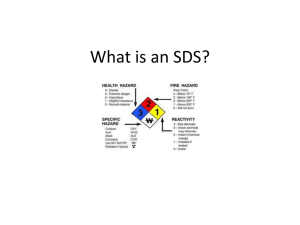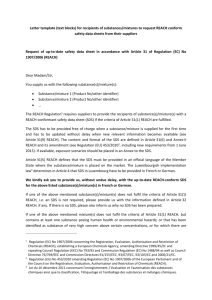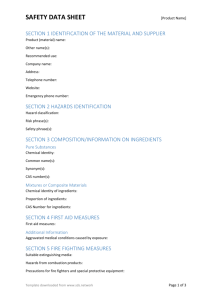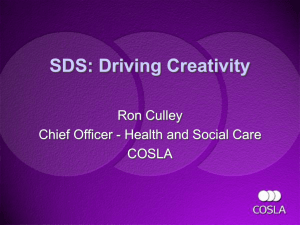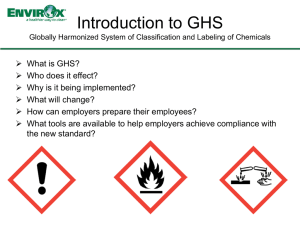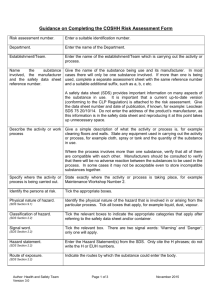Safety Data Sheets and Resource Material
advertisement
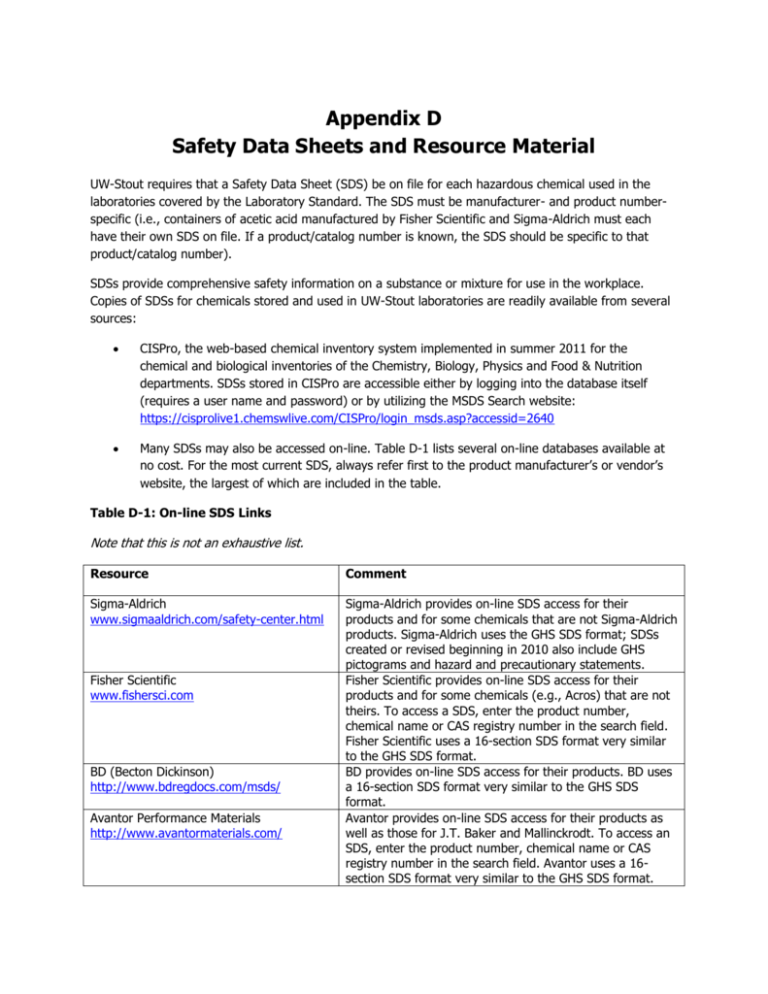
Appendix D Safety Data Sheets and Resource Material UW-Stout requires that a Safety Data Sheet (SDS) be on file for each hazardous chemical used in the laboratories covered by the Laboratory Standard. The SDS must be manufacturer- and product numberspecific (i.e., containers of acetic acid manufactured by Fisher Scientific and Sigma-Aldrich must each have their own SDS on file. If a product/catalog number is known, the SDS should be specific to that product/catalog number). SDSs provide comprehensive safety information on a substance or mixture for use in the workplace. Copies of SDSs for chemicals stored and used in UW-Stout laboratories are readily available from several sources: CISPro, the web-based chemical inventory system implemented in summer 2011 for the chemical and biological inventories of the Chemistry, Biology, Physics and Food & Nutrition departments. SDSs stored in CISPro are accessible either by logging into the database itself (requires a user name and password) or by utilizing the MSDS Search website: https://cisprolive1.chemswlive.com/CISPro/login_msds.asp?accessid=2640 Many SDSs may also be accessed on-line. Table D-1 lists several on-line databases available at no cost. For the most current SDS, always refer first to the product manufacturer’s or vendor’s website, the largest of which are included in the table. Table D-1: On-line SDS Links Note that this is not an exhaustive list. Resource Comment Sigma-Aldrich www.sigmaaldrich.com/safety-center.html Sigma-Aldrich provides on-line SDS access for their products and for some chemicals that are not Sigma-Aldrich products. Sigma-Aldrich uses the GHS SDS format; SDSs created or revised beginning in 2010 also include GHS pictograms and hazard and precautionary statements. Fisher Scientific provides on-line SDS access for their products and for some chemicals (e.g., Acros) that are not theirs. To access a SDS, enter the product number, chemical name or CAS registry number in the search field. Fisher Scientific uses a 16-section SDS format very similar to the GHS SDS format. BD provides on-line SDS access for their products. BD uses a 16-section SDS format very similar to the GHS SDS format. Avantor provides on-line SDS access for their products as well as those for J.T. Baker and Mallinckrodt. To access an SDS, enter the product number, chemical name or CAS registry number in the search field. Avantor uses a 16section SDS format very similar to the GHS SDS format. Fisher Scientific www.fishersci.com BD (Becton Dickinson) http://www.bdregdocs.com/msds/ Avantor Performance Materials http://www.avantormaterials.com/ Resource Comment Vermont SIRI MSDS Database http://siri.org/msds/ The University of Vermont maintains a relatively large database of SDSs for chemicals and products. The database can be searched by manufacturer or chemical name. On March 26, 2012 OSHA published its updated Hazard Communication standard in the Federal Register, which mandates use of the Globally Harmonized System of Classification and Labeling of Chemicals (GHS) 16-section format by June 1, 2015. Certain sections that do not fall under the jurisdiction of OSHA are regulated by their specific agency (e.g., transport information will be covered by the U.S. Department of Transportation and ecological information will be covered by the Environmental Protection Agency). A summary of the 16-section GHS SDS format with main components of each section is found in Table D2 below. It is important that all employees are familiar with the format and terminology used on SDSs since this are considered a primary source of chemical safety information. Table D-2: Summary of GHS SDS Sections GHS SDS section 1. Product and company identification 2. Hazards identification 3. Composition/information on ingredients 4. First-aid measures 5. Firefighting measures 6. Accidental release measures 7. Handling and storage 8. Exposure controls/personal protection 9. Physical and chemical properties 10. Stability and reactivity 11. Toxicological information Content Product identifier Manufacturer or distributor name, address, phone number Emergency phone number Recommended use Restrictions on use All hazards regarding the chemical Required label elements Information on chemical ingredients Trade secret claims Important symptoms/effects, acute, delayed Required treatment Suitable extinguishing techniques, equipment Chemical hazards from fire Emergency procedures Protective equipment Proper methods of containment and cleanup Precautions for safe handling Conditions for safe storage, including any incompatibilities OSHA’s Permissible Exposure Limits Threshold Limit Values Appropriate engineering controls Personal protective equipment Chemical characteristics Chemical stability Possibility of hazardous reactions Routes of exposure Related symptoms, acute and chronic effects Numerical measures of toxicity GHS SDS section 12. Ecological information 13. Disposal considerations 14. Transport information 15. Regulatory information 16. Other information Content Exotoxicity Persistence and degradability Bioaccumulative potential Mobility in soil Other adverse effects Description of waste residues and information on their safe handling and methods of disposal, including any contaminated packaging UN number UN proper shipping name. Transport hazard class(es) Packing group, if applicable Marine pollutant (Y/N) Special precautions which a user needs to be aware of or needs to comply with in connection with transport or conveyance either within or outside their premises Safety, health and environmental regulations specific for the product in question Including date of preparation or last revision Table D-3 contains a list of additional resources on chemical safety. This list includes links to several reputable chemical safety resources (primarily governmental agencies) that are available at no cost. Table D-3: Additional Chemical Safety Resources NIOSH Pocket Guide to Chemical Hazards http://www.cdc.gov/niosh/npg/default.html International Chemical Safety Cards http://www.cdc.gov/niosh/ipcs/icstart.html The NIOSH Pocket Guide to Chemical Hazards (NPG) is intended as a source of general industrial hygiene information on several hundred chemicals/classes for workers, employers and occupational health professionals. It presents key information and data in abbreviated or tabular form for chemicals or substance groupings that are found in the workplace. It includes chemical names, Registry of Toxic Effects of Chemical Substances information, exposure limits, physical description, measurement methods, PPE recommendations, and respirator recommendations. International Chemical Safety Cards (ICSCs) summarize essential health and safety information on chemicals for their use at the “shop floor” level by workers and employers in factories, agriculture, construction and other work places. Information provided in user friendly format in several languages. Good supplement to SDSs. Limitations: ICSCs have been developed for a limited number of substances. Laboratory Chemical Safety Summaries http://dwb4.unl.edu/Chem/CHEM869V/CHE M869VLinks/www.qrc.com/hhmi/science/la bsafe/lcss/start.htm OSHA Occupational Chemical Database https://www.osha.gov/chemicaldata/ NIOSH chemical page http://www.cdc.gov/niosh/topics/chemical. html NIOSH databases www.cdc.gov/niosh/database.html Laboratory Chemical Safety Summaries (LCSSs) were prepared by the National Research Council, Committee on Prudent Practices for Handling, Storage, and Disposal of Chemicals in Laboratories. They provide concise critical discussions of the toxicity, flammability, reactivity, and explosivity of a limited number of chemicals commonly used in scientific research laboratories. Directions for handling, storage and disposal and special instructions for first aid and emergency response are given. Since many of these chemicals are representative of a class of potentially hazardous compounds, the LCSSs can also be used as guides to handling many other compounds with related chemical structures. LCSSs are designed especially for laboratory workers. They are an excellent complement to the substance SDS. OSHA maintains this database as a convenient reference for the occupational safety and health community. This database compiles information from several government agencies and organizations. Links to information on many specific chemicals is found on this page. Links to a number of useful databases in addition to the NPG and ICSCs links referenced above.

